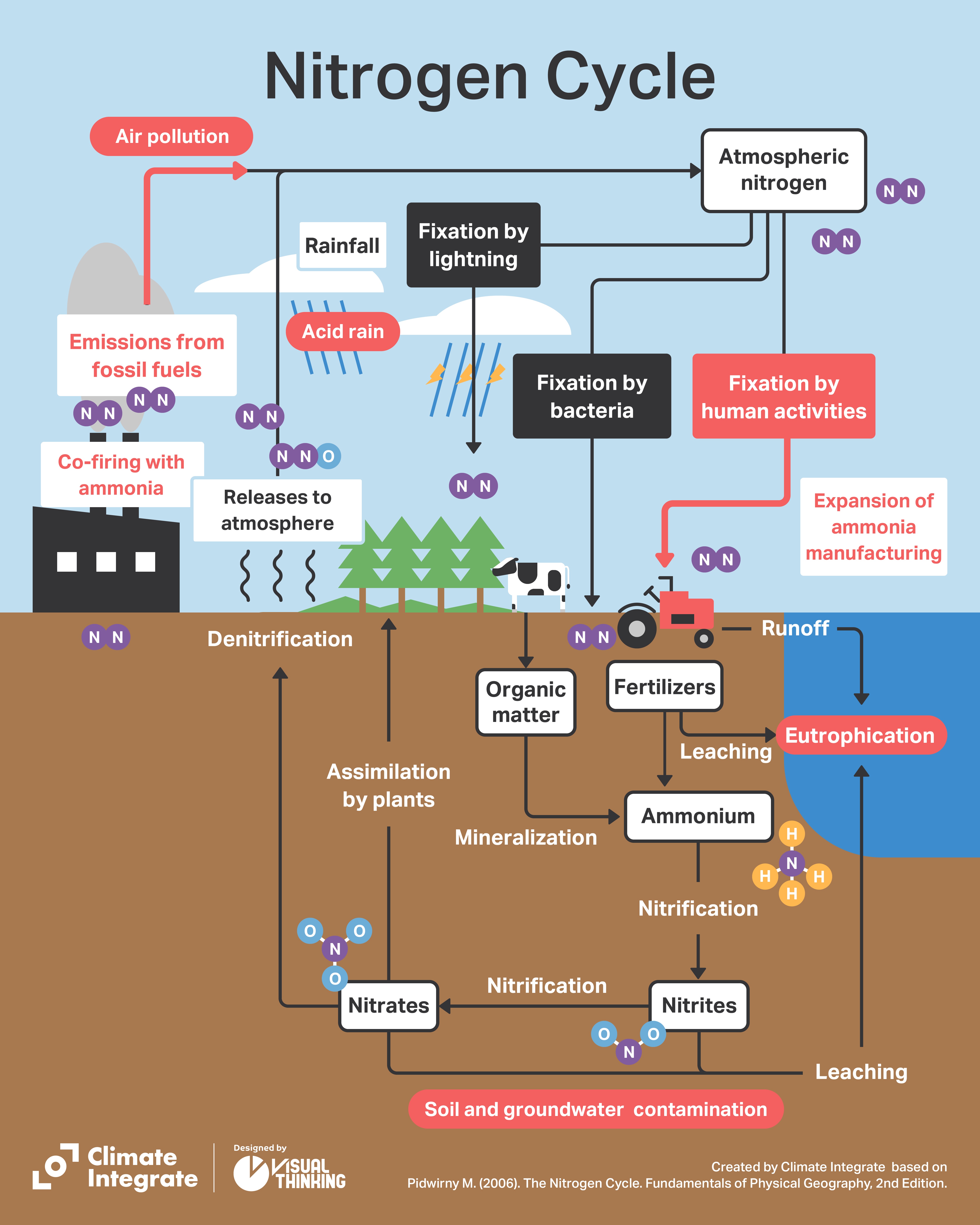Home>Articles>How Does The Use Of Fertilizer Affect The Nitrogen Cycle?


Articles
How Does The Use Of Fertilizer Affect The Nitrogen Cycle?
Modified: October 28, 2024
Discover the impact of fertilizer on the nitrogen cycle with informative articles. Understand how its use affects the delicate balance of this essential ecological process.
(Many of the links in this article redirect to a specific reviewed product. Your purchase of these products through affiliate links helps to generate commission for Storables.com, at no extra cost. Learn more)
Introduction
When it comes to agricultural practices that aim to boost crop production and yield, the use of fertilizer plays a significant role. Fertilizer provides essential nutrients to plants, promoting healthy growth and development. However, the use of fertilizer can have profound effects on the nitrogen cycle, which is crucial for maintaining the balance of nitrogen in ecosystems.
In this article, we will explore how the use of fertilizer affects the nitrogen cycle and its implications for the environment. We will examine the role of nitrogen in ecosystems, the use of fertilizer in agriculture, and the various ways that fertilizer impacts nitrogen cycling. Furthermore, we will discuss the consequences of these effects, such as water pollution, eutrophication, and soil health issues.
Understanding the relationship between fertilizer use and the nitrogen cycle is essential for sustainable agriculture and environmental conservation. By employing responsible fertilizer management practices, we can mitigate the negative impacts and promote a healthier ecosystem for future generations.
Key Takeaways:
- Sustainable fertilizer management practices are crucial for minimizing environmental impacts, optimizing nutrient use, and promoting long-term soil health in agricultural systems.
- The delicate balance of the nitrogen cycle can be preserved through responsible fertilizer management, leading to increased crop productivity, water quality protection, and biodiversity preservation.
Read also: 13 Best Nitrogen Fertilizer for 2025
The Nitrogen Cycle: A Brief Overview
The nitrogen cycle is a natural biological process that continuously recycles nitrogen in the environment. Nitrogen is an essential element for all living organisms, as it is a vital component of amino acids, proteins, and DNA. The nitrogen cycle consists of various processes that convert nitrogen from one form to another, allowing it to be utilized by different organisms.
The nitrogen cycle begins with nitrogen fixation, where specialized bacteria convert atmospheric nitrogen (N2) into ammonium (NH4+). This process occurs through biological nitrogen fixation by certain bacteria living in the soil or symbiotic relationships with plants. Additionally, industrial processes such as the Haber-Bosch process convert atmospheric nitrogen into ammonia for the production of synthetic fertilizers.
Once nitrogen is in the form of ammonium, it can be taken up by plants and incorporated into their tissues. This process is known as assimilation. Nitrogen is then passed through the food chain as organisms consume plants or other animals, transferring the nitrogen from one organism to another.
When plants and animals die, nitrogen is released through the decomposition process. Decomposers, such as bacteria and fungi, break down organic matter and convert the nitrogen compounds back into ammonium.
However, the nitrogen cycle also includes processes that convert ammonium into other forms, such as nitrification and denitrification. Nitrification is the oxidation of ammonium into nitrate (NO3-) by nitrifying bacteria, while denitrification is the reduction of nitrate back into atmospheric nitrogen by denitrifying bacteria. These processes help maintain the balance of nitrogen in the environment.
Overall, the nitrogen cycle is a complex and interconnected system that ensures a continuous supply of nitrogen for the growth and development of organisms. It is a delicate balance that can be disrupted by human activities, such as the excessive use of fertilizer in agriculture.
Role of Nitrogen in Ecosystems
Nitrogen is a crucial element for the functioning of ecosystems as it is an essential component of proteins, nucleic acids, and chlorophyll. It plays a vital role in various biological processes, including plant growth, nutrient cycling, and energy transfer.
One of the key roles that nitrogen plays in ecosystems is in plant growth. Nitrogen is a primary nutrient required by plants for photosynthesis, which is the process by which plants convert sunlight into energy. It is a key component of chlorophyll, the pigment responsible for capturing sunlight and initiating the photosynthetic process.
Nitrogen also plays a critical role in plant development and overall productivity. It is necessary for the synthesis of amino acids, the building blocks of proteins. Proteins are involved in nearly all biological functions, including cell structure, enzyme activity, and defense mechanisms. Adequate nitrogen availability in the soil directly influences plant growth, leaf development, and the production of fruits and seeds.
In addition to its role in plant growth, nitrogen is a fundamental component of the nutrient cycle in ecosystems. It is involved in the cycling of nutrients between the living and non-living components of the environment. Nitrogen is taken up by plants from the soil, assimilated into organic compounds, and passed through the food chain as organisms consume other organisms.
Nitrogen fixation, the process by which atmospheric nitrogen is converted into a usable form by certain bacteria, is another critical role of nitrogen in ecosystems. Nitrogen-fixing bacteria have a symbiotic relationship with certain plants, such as legumes, where they live in specialized structures called nodules on the roots. These bacteria convert atmospheric nitrogen into a form that can be used by plants, increasing the availability of nitrogen in the ecosystem.
Overall, nitrogen is an essential element that is intimately connected to the functioning of ecosystems. It is vital for plant growth, nutrient cycling, and the overall productivity and stability of ecosystems. The balance and availability of nitrogen in the environment are crucial for the health and sustainability of ecosystems and the organisms that depend on them.
The Use of Fertilizer in Agriculture
Fertilizers are substances that are applied to soil or plants to provide essential nutrients that may be lacking for optimal growth and development. They are commonly used in agriculture to maximize crop yields and ensure the availability of nutrients necessary for plant growth.
The use of fertilizers in agriculture has significantly contributed to increased food production and improved crop quality. Fertilizers provide essential nutrients such as nitrogen (N), phosphorus (P), and potassium (K), also known as NPK, in forms that are readily available for plant uptake.
Nitrogen is a vital nutrient for plants as it is required for the production of proteins, enzymes, and chlorophyll. Phosphorus is essential for energy transfer and metabolism, while potassium plays a role in osmotic regulation and enzyme activation.
Traditional fertilizers are classified into two categories: organic and inorganic. Organic fertilizers are derived from plant or animal sources, such as compost, manure, or bone meal. They release nutrients slowly as they are broken down by microorganisms in the soil. Organic fertilizers also improve soil structure and enhance water-holding capacity.
Inorganic fertilizers, on the other hand, are synthetic substances that are manufactured using industrial processes. They typically contain a higher concentration of nutrients and are more readily available for plant uptake. Inorganic fertilizers can be further classified into nitrogenous, phosphatic, and potassic fertilizers, depending on the primary nutrient they provide.
The use of fertilizers in agriculture has revolutionized farming practices and has helped meet the demands of an increasing global population. By providing essential nutrients that may be deficient in the soil, fertilizers have increased crop yields, improved crop uniformity, and shortened growing seasons.
However, it is crucial to note that the excessive or improper use of fertilizers can have detrimental effects on the environment and ecosystem health. Overuse of fertilizers can lead to nutrient runoff, groundwater contamination, and the disruption of natural nutrient cycles.
As such, proper nutrient management and responsible fertilizer application practices are crucial in achieving sustainable agriculture. This includes conducting soil tests to determine nutrient deficiencies, precision application techniques, and adopting nutrient management plans tailored to specific crops and soil conditions.
By carefully managing fertilizer use in agriculture, we can maximize the benefits of increased crop productivity while minimizing the negative impacts on the environment.
Effects of Fertilizer on Nitrogen Cycling
The use of fertilizers in agriculture can have significant effects on the nitrogen cycle, disrupting the natural balance of nitrogen in ecosystems. Understanding these effects is crucial for mitigating the potential environmental consequences of fertilizer use.
One of the primary effects of fertilizer is the input of excess nitrogen into the environment. Fertilizers, especially those high in nitrogen, are applied to crops to promote growth and increase yields. However, not all the applied nitrogen is taken up by plants. The surplus nitrogen can seep into the soil and be washed away through leaching or runoff.
Leaching occurs when excessive rainfall or irrigation water carries the nitrogen compounds deeper into the soil layers. This can result in groundwater contamination, as the excess nitrogen can enter water bodies through underground aquifers. Elevated levels of nitrates in drinking water can be harmful to human health, particularly for infants and pregnant women.
Runoff refers to the flow of water carrying nitrogen compounds over the soil surface, most commonly during heavy rainfall or snowmelt. Nitrogen-containing compounds, such as nitrate and ammonium, can enter nearby water bodies, such as rivers, lakes, and streams. This influx of nitrogen can lead to water pollution and the disruption of aquatic ecosystems.
The excessive input of nitrogen from fertilizers can also contribute to eutrophication, a process characterized by the excessive growth of algae and aquatic plants in water bodies. When nitrogen-rich water enters lakes or rivers, it provides nutrients that stimulate the rapid growth of algae. This overabundance of algae can block sunlight and deplete oxygen levels, leading to the death of fish and other aquatic organisms.
Fertilizers can also impact nitrogen cycling through their influence on the processes of nitrogen fixation and denitrification. Excessive nitrogen levels can inhibit the activity of nitrogen-fixing bacteria, reducing their ability to convert atmospheric nitrogen into a usable form for plants. Additionally, high nitrogen availability can promote denitrification, the process where nitrate is converted back into atmospheric nitrogen, releasing it into the air and reducing its availability for plants.
Furthermore, the misuse or excessive use of fertilizers can create imbalances in soil nutrient levels. High concentrations of nitrogen can disrupt the ratios of other essential nutrients, such as phosphorus and potassium. This can negatively impact plant health and growth, leading to nutrient deficiencies or toxicities in crops.
Overall, the use of fertilizers can significantly alter the nitrogen cycle. The input of excess nitrogen can result in environmental pollution, eutrophication of water bodies, disruption of nitrogen-fixing and denitrifying processes, and imbalances in soil nutrient levels. It is essential to adopt responsible fertilizer management practices to minimize these negative impacts and maintain a healthy nitrogen cycle in ecosystems.
Leaching and Runoff of Nitrogen from Fertilizer
Leaching and runoff are two significant pathways through which nitrogen from fertilizer can be lost from agricultural systems and enter the environment. These processes can have detrimental effects on water quality and ecosystem health.
Leaching occurs when excess nitrogen from fertilizers is carried downward through the soil profile by water. When fertilizers are applied to fields, the nitrogen compounds can dissolve in water and move with percolating water deeper into the soil layers. This downward movement can be facilitated by factors such as heavy rainfall, irrigation, or excessive watering.
The severity of leaching depends on several factors, including soil type, rainfall intensity, and the type of fertilizer used. Sandy soils, which have larger pore spaces and less capacity to hold onto nutrients, are more prone to nitrogen leaching compared to soils with higher clay content.
Once the nitrogen-laden water reaches the groundwater, it can contaminate drinking water sources. Elevated levels of nitrates in drinking water can pose health risks, particularly for infants and pregnant women, as it can interfere with the blood’s ability to carry oxygen.
Runoff, on the other hand, occurs when water carrying nitrogen compounds from fertilizers flows over the soil surface instead of infiltrating into the soil. Runoff typically happens during heavy rainfall or snowmelt events when the soil becomes saturated, preventing water absorption.
When runoff occurs, it can carry nitrogen-containing compounds, such as nitrates and ammonium, along with other pollutants, downstream into nearby rivers, lakes, and streams. This influx of nitrogen-rich water can result in water pollution and disrupt the delicate balance of aquatic ecosystems.
The impacts of excess nitrogen runoff are particularly concerning in coastal areas. The nitrogen compounds can fuel the growth of algae and aquatic plants, leading to eutrophication. The excessive growth of algae can deplete oxygen levels in the water, resulting in “dead zones” where fish and other organisms cannot survive.
To mitigate the leaching and runoff of nitrogen from fertilizers, various best management practices (BMPs) can be implemented. These practices aim to increase nutrient use efficiency and reduce the potential for nitrogen losses into the environment.
Some effective BMPs include precision application techniques, such as split application and site-specific fertilization, which improve nutrient targeting and reduce the use of excess fertilizers. Additionally, incorporating cover crops, buffer strips, and conservation tillage practices can help promote water infiltration, reduce erosion, and retain nutrients in the soil, thus minimizing the potential for leaching and runoff.
Overall, minimizing the leaching and runoff of nitrogen from fertilizers is crucial for preserving water quality and protecting aquatic ecosystems. It requires a combination of responsible fertilizer application practices and the implementation of appropriate management strategies to ensure sustainable agriculture while minimizing environmental impacts.
Impacts on Water Quality
The use of fertilizers in agriculture can have significant impacts on water quality, particularly when excessive amounts of nitrogen and phosphorus from fertilizers enter water bodies through runoff and leaching. These nutrient inputs can lead to various water quality issues and pose risks to both human health and aquatic ecosystems.
One of the primary concerns associated with excessive nutrient inputs is the process of eutrophication. When nitrogen and phosphorus from fertilizers are washed into lakes, rivers, and streams, they stimulate the growth of algae and aquatic plants. This excessive plant growth can lead to the formation of algal blooms, which can have negative impacts on water quality and ecosystem health.
As the algal blooms proliferate, they can block sunlight from reaching deeper water layers, inhibiting the growth of submerged aquatic plants and phytoplankton. This reduction in light availability can disrupt the entire food chain, leading to a decline in the populations of fish and other aquatic organisms that depend on these primary producers.
Furthermore, algal blooms can deplete dissolved oxygen levels in the water through the process of respiration. During periods of excessive algae growth and subsequent die-offs, bacteria break down the organic matter, consuming large amounts of oxygen in the process. This depletion of oxygen can lead to hypoxic or anoxic conditions in which oxygen-dependent organisms struggle to survive.
Another water quality concern associated with excess nutrient inputs is the contamination of drinking water sources. Nitrogen from fertilizers can leach into groundwater, where it can accumulate and contaminate wells and aquifers. Elevated nitrate levels in drinking water are particularly problematic, as they can interfere with the blood’s ability to carry oxygen, leading to a condition called methemoglobinemia, or “blue baby syndrome,” in infants.
Moreover, excess nutrients in water bodies can lead to the growth of toxic algae species, such as cyanobacteria. These harmful algal blooms can produce toxins, known as cyanotoxins, which can have severe health impacts on humans and animals. Exposure to these toxins through recreational activities or drinking water consumption can cause symptoms ranging from skin rashes to liver damage or even neurological effects.
To address and mitigate the impacts of excessive nutrient inputs on water quality, it is essential to implement best management practices (BMPs). These practices include precision application of fertilizers, responsible nutrient management, and the establishment of buffer zones and riparian buffers along water bodies to reduce nutrient runoff and promote natural filtration.
Effective watershed management approaches, such as implementing conservation tillage and cover cropping techniques, can also help to prevent erosion, improve soil health, and reduce nutrient losses. These practices not only protect water quality but also promote sustainable agriculture by optimizing fertilization efficiency and minimizing environmental impacts.
By adopting these proactive measures, we can safeguard water quality, protect human health, and preserve the ecological integrity of aquatic ecosystems for present and future generations.
Tip: Excessive use of fertilizer can lead to an increase in nitrogen runoff, which can contribute to water pollution and harm aquatic ecosystems. It’s important to use fertilizers sparingly and follow recommended application rates.
Eutrophication and Harmful Algal Blooms
Eutrophication is a process in which water bodies, such as lakes, rivers, and coastal areas, become excessively enriched with nutrients, particularly nitrogen and phosphorus. The primary source of these nutrients is often the runoff from agricultural fields where fertilizers are used. Eutrophication can have several detrimental effects on water quality and ecosystem balance.
One of the most significant consequences of eutrophication is the formation of harmful algal blooms (HABs). When nitrogen and phosphorus from fertilizer runoff enter water bodies, they promote the rapid growth of algae and other aquatic plants. This excessive growth can create dense blooms on the water’s surface, discoloring the water and disrupting its clarity.
HABs can be harmful to both the environment and human health. Some species of algae produce toxins, known as cyanotoxins, which can cause harm to humans, wildlife, and marine ecosystems. These toxins can be ingested or inhaled, leading to various health problems, ranging from skin irritations and gastrointestinal issues to liver damage and neurotoxic effects.
In addition to the direct health risks, harmful algal blooms can have detrimental effects on aquatic ecosystems. The dense growth of algae can block sunlight from reaching submerged plants and phytoplankton, reducing their photosynthetic capabilities. This can lead to a decline in the populations of these primary producers, disrupting the aquatic food chain.
Furthermore, the decomposition of excessive algal biomass consumes a significant amount of oxygen, leading to oxygen depletion in the water. Low oxygen levels, or hypoxia, can contribute to fish kills and the death of other organisms that rely on oxygen for survival.
Eutrophication and harmful algal blooms are not limited to freshwater systems; they can also occur in coastal areas and marine ecosystems. The excessive nutrient runoff from agriculture can be transported to coastal regions, where it stimulates algal growth and leads to the formation of harmful blooms. These blooms can have severe impacts on coastal habitats, including coral reefs and seagrass beds, which are vital for the overall health and biodiversity of marine ecosystems.
To mitigate the effects of eutrophication and harmful algal blooms, it is essential to implement nutrient management practices in agriculture. Precision application of fertilizers, based on soil testing and crop needs, can help reduce runoff and minimize nutrient losses into water bodies.
Additionally, implementing buffer zones and riparian buffers along water bodies can act as natural filters, reducing the amount of nutrients and sediments that enter the water. Conservation practices, such as cover cropping, reduced tillage, and rotational grazing, can help improve soil health, prevent erosion, and reduce nutrient runoff from agricultural fields.
Efforts to improve wastewater treatment and manage stormwater runoff can also contribute to reducing nutrient inputs into water bodies. By implementing these measures, we can mitigate the impacts of eutrophication and harmful algal blooms, protecting water quality and preserving the health of aquatic ecosystems for future generations.
Nitrogen Fixation and Denitrification
Nitrogen fixation and denitrification are vital processes in the nitrogen cycle, playing key roles in converting nitrogen between different forms and maintaining a balance of nitrogen in ecosystems.
Nitrogen fixation is the process by which certain bacteria convert atmospheric nitrogen (N2) into a biologically usable form such as ammonium (NH4+). This conversion allows nitrogen to enter the food web and become available for plant uptake. Nitrogen-fixing bacteria have a symbiotic relationship with certain plants, forming nodules on their roots or stems. These bacteria have the enzyme nitrogenase, which allows them to break the strong triple bond in atmospheric nitrogen and convert it into a form that plants can use.
Some nitrogen-fixing bacteria are free-living, occurring in the soil or water. They can convert atmospheric nitrogen into ammonium, increasing the availability of nitrogen for other organisms. Additionally, industrial processes, such as the Haber-Bosch process, artificially fix nitrogen to produce ammonia for the production of synthetic fertilizers.
Denitrification, on the other hand, is the process by which certain bacteria convert nitrate (NO3-) back into atmospheric nitrogen (N2), completing the nitrogen cycle. Denitrifying bacteria are anaerobic, meaning they thrive in low-oxygen or oxygen-depleted environments such as wetlands or waterlogged soils. These bacteria use nitrate as an alternative electron acceptor in the absence of oxygen, breaking it down into nitrogen gas and releasing it back into the atmosphere.
Denitrification removes nitrogen from ecosystems and returns it to the atmosphere, reducing the overall availability of nitrogen for plants and other organisms. This process is crucial for maintaining a balance in nitrogen levels. Without denitrification, nitrogen would continue to accumulate, leading to excessive nutrient inputs and potential imbalances in ecosystems.
Both nitrogen fixation and denitrification are essential for the functioning of ecosystems and the availability of nitrogen for biological processes. However, human activities, particularly the excessive use of fertilizers and other industrial processes, can greatly influence these processes and disrupt the natural balance of nitrogen in the environment.
Excessive nitrogen inputs from fertilizers can reduce the activity of nitrogen-fixing bacteria, as plants may have an oversupply of nitrogen and no longer require the mutually beneficial relationship with these bacteria. Additionally, the use of synthetic fertilizers can contribute to increased nitrate levels in groundwater, impacting the potential for denitrification in waterlogged or low-oxygen areas.
Understanding the processes of nitrogen fixation and denitrification is crucial for sustainable agriculture and environmental management. A balance between nitrogen inputs and outputs is necessary to prevent the accumulation of nitrogen and its negative impacts on water quality, ecosystem health, and biodiversity. Implementing responsible fertilizer management, conserving wetland habitats, and adopting sustainable agricultural practices can help mitigate the disruptions to nitrogen fixation and denitrification, ensuring the health and sustainability of ecosystems.
Read also: 14 Amazing High Nitrogen Fertilizer for 2025
Loss of Biodiversity and Species Disruption
The excessive use of fertilizers and the resulting impacts on the nitrogen cycle can lead to the loss of biodiversity and disruptions to various species within ecosystems. These effects have far-reaching consequences for the overall health and functioning of ecosystems.
When fertilizers are applied in high amounts, particularly in monoculture agricultural systems, certain plant species can outcompete others due to their increased access to nutrients. This dominance of certain species can lead to a reduction in plant biodiversity, as other plant species are unable to thrive in nutrient-rich environments. As a result, the overall diversity and resilience of ecosystems can decline.
Changes in vegetation composition caused by excessive nitrogen inputs can also impact herbivores and other organisms that rely on specific plant species for food and habitat. Some species may become more abundant due to the availability of nitrogen-rich plants, while others may decline or even disappear as their preferred food sources are outcompeted or no longer available.
In addition to the direct effects on plant species, excessive nitrogen inputs can alter the microbial communities in the soil. Nitrogen-loving bacteria can proliferate in response to high nutrient levels, potentially suppressing the growth and diversity of other microbial groups. This disruption of soil microbial communities can have cascading effects on nutrient cycling processes, affecting plant health and overall ecosystem functioning.
The loss of biodiversity and disruptions to species interactions caused by nitrogen inputs can also impact higher trophic levels. For example, declines in plant diversity can reduce the availability of food and habitat for herbivores and ultimately affect the abundance and diversity of predators or higher-level predators in the food chain.
The disruption of species interactions due to nitrogen inputs can also extend to pollinators and other beneficial insects. Changes in plant communities resulting from excessive nitrogen can alter the availability and quality of nectar and pollen resources, which are vital for the survival and reproduction of many insect species. This can have negative implications for pollination services and overall ecosystem biodiversity.
Furthermore, excessive nitrogen inputs can promote the growth of invasive plant species that are better adapted to high nutrient levels. These invasives can outcompete native species, leading to the loss of indigenous plant diversity and the disruption of ecosystem functions and interactions.
To mitigate the negative impacts on biodiversity and species disruption, implementing sustainable agricultural practices and responsible nutrient management is essential. These practices include reducing fertilizer use, adopting crop rotation and cover cropping techniques, and creating diverse habitat patches within agricultural landscapes.
Conserving and restoring natural habitats, such as forests, wetlands, and meadows, is also crucial for supporting biodiversity and providing refuge for species affected by nitrogen inputs. By promoting a more balanced and diverse ecosystem, we can enhance resilience, restore species interactions, and safeguard the overall health of the natural environment.
Soil Health and Nutrient Imbalances
The use of fertilizers in agriculture can have both positive and negative effects on soil health. While fertilizers can provide essential nutrients necessary for plant growth, excessive or improper use can lead to nutrient imbalances, degradation of soil quality, and a decline in overall soil health.
One of the main concerns associated with the excessive use of fertilizers is the potential for nutrient imbalances in the soil. Fertilizers often focus on providing primary nutrients such as nitrogen (N), phosphorus (P), and potassium (K), also known as NPK. However, other essential nutrients, such as micronutrients like iron, zinc, and manganese, are also vital for plant growth and development.
When fertilizers are overused, there is a higher risk of nutrient imbalances, where an excess of one nutrient can hinder the uptake or availability of other nutrients. For example, excessive nitrogen fertilization can lead to a deficiency of other nutrients such as phosphorus or potassium. This imbalance can negatively affect plant health and growth, reducing overall productivity and crop quality.
Nutrient imbalances can also disrupt soil microbial communities. Microorganisms play a crucial role in soil health and fertility by decomposing organic matter, cycling nutrients, and improving soil structure. When nutrient imbalances occur, certain microbial groups may become less abundant, affecting nutrient cycling processes and overall soil health.
The excessive use of fertilizers can also contribute to soil acidification. Nitrogen-based fertilizers, in particular, can acidify the soil as they release nitric and ammonic acids during the nitrification process. Soil acidification can negatively impact soil structure, nutrient availability, and microbial activity, ultimately affecting plant growth and overall soil health.
Moreover, the reliance on synthetic fertilizers can lead to a decline in organic matter content in soils. Organic matter provides numerous benefits to soil health, such as improving water-holding capacity, enhancing nutrient retention, and supporting beneficial soil organisms. Excessive fertilizer use can reduce the decomposition of organic matter by microorganisms, leading to a decline in soil organic carbon and overall soil fertility.
To mitigate the negative impacts on soil health and nutrient imbalances, it is essential to adopt sustainable soil management practices. This includes conducting regular soil testing to determine nutrient deficiencies and adjusting fertilizer applications accordingly. Precision agriculture techniques, such as site-specific fertilization and variable rate application, can help optimize nutrient inputs and reduce waste.
Implementing organic farming practices can help restore soil health by increasing organic matter content, improving soil structure, and enhancing soil microbial activity. Crop rotation, cover cropping, and the use of compost or other organic amendments can contribute to nutrient recycling, decrease the reliance on synthetic fertilizers, and improve overall soil health.
Conservation practices, such as conservation tillage or no-till farming, can help reduce erosion and promote soil organic matter accumulation. The inclusion of legume cover crops in rotations can also enhance nitrogen fixation, reducing the need for synthetic nitrogen fertilizers.
By adopting these sustainable soil management practices, farmers can minimize nutrient imbalances, enhance soil health, and ensure the long-term productivity and sustainability of agricultural systems.
Sustainable Fertilizer Management Practices
To minimize the negative impacts of fertilizer use on the environment and promote sustainable agriculture, it is essential to adopt responsible and efficient fertilizer management practices. Implementing these practices can help optimize nutrient use, reduce nutrient losses, and improve overall nutrient cycling in agricultural systems.
Here are some sustainable fertilizer management practices that can be employed:
- Soil Testing: Conduct regular soil tests to assess the nutrient status of the soil. Soil testing helps determine the specific nutrient requirements of crops, allowing for targeted fertilizer application and avoiding unnecessary nutrient inputs.
- Precision Application: Use precision agriculture techniques to apply fertilizers accurately. Variable rate application and site-specific fertilization allow for the precise application of fertilizers based on soil variability, crop needs, and yield goals. This can prevent over-fertilization and reduce nutrient losses.
- Timing and Placement: Apply fertilizers at the appropriate time and place them where they are most needed. This ensures that nutrients are available when crops need them the most. Placing fertilizers closer to the root zone or using techniques like deep placement can improve nutrient uptake and minimize losses.
- Crop Rotation: Practice crop rotation to diversify nutrient demands and enhance nutrient cycling. Different crops have varying nutrient requirements, which can help prevent the buildup of specific nutrient imbalances in the soil. Crop rotations that include nitrogen-fixing legumes can also contribute to natural nitrogen fixation and reduce the need for synthetic nitrogen fertilizers.
- Cover Crops: Incorporate cover crops into rotations to reduce nutrient leaching and erosion. Cover crops capture excess nutrients, prevent soil erosion, and improve soil organic matter content. They act as living mulches, enhancing soil health and reducing the need for additional fertilizers.
- Conservation Tillage: Implement conservation tillage or no-till practices to enhance soil moisture retention, reduce erosion, and promote organic matter accumulation. Minimizing soil disturbance helps maintain soil structure, improve nutrient cycling, and enhance the overall health of the soil ecosystem.
- Use of Organic Amendments: Incorporate organic amendments, such as compost or manure, to improve soil fertility, increase organic matter content, and enhance nutrient availability. Organic amendments also contribute to the long-term sustainability of the soil by improving soil structure and promoting beneficial soil microbial activity.
- Education and Training: Provide education and training to farmers on sustainable fertilizer management techniques, emphasizing the importance of nutrient stewardship, nutrient cycling, and the environmental impacts of excessive fertilizer use. This promotes awareness and adoption of sustainable practices in agricultural systems.
By implementing these sustainable fertilizer management practices, farmers can optimize nutrient use efficiency, reduce nutrient losses to the environment, protect water quality, and promote long-term soil health. These practices contribute to the sustainability and resilience of agricultural systems, ensuring the provision of safe and nutritious food while minimizing environmental impacts. It is crucial for stakeholders, including farmers, researchers, policymakers, and consumers, to collaborate and support the adoption of these sustainable practices for the benefit of present and future generations.
Conclusion
The use of fertilizers in agriculture undoubtedly plays a significant role in boosting crop production and meeting the demands of a growing population. However, it is essential to recognize the potential impacts of fertilizer use on the nitrogen cycle and the environment at large.
The nitrogen cycle, a delicate and interconnected system, is crucial for maintaining the balance of nitrogen in ecosystems. Excessive or improper use of fertilizers can disrupt this cycle, leading to numerous environmental issues and ecological imbalances.
From leaching and runoff, which contaminate water bodies and contribute to eutrophication and harmful algal blooms, to the disruption of nitrogen-fixing and denitrifying processes, the effects of fertilizer usage are far-reaching. These impacts extend to the loss of biodiversity, species disruption, soil degradation, and nutrient imbalances.
However, by employing sustainable fertilizer management practices, we can mitigate these negative effects and promote a more environmentally friendly approach to agriculture.
Practices such as soil testing, precision application, timing and placement, crop rotation, cover cropping, conservation tillage, and the use of organic amendments can help optimize nutrient use, reduce nutrient losses, enhance soil health, and improve overall nutrient cycling in agricultural systems.
These sustainable practices not only minimize environmental impacts but also contribute to the long-term sustainability of agriculture. By adopting responsible fertilizer management, farmers can boost crop productivity, protect water quality, preserve biodiversity, and ensure the fertility and health of soils for future generations.
Moving forward, it is crucial for stakeholders across the agricultural sector to prioritize the implementation of sustainable fertilizer management practices. Farmers, researchers, policymakers, and consumers must work together to raise awareness, provide education and training, and support the adoption of these practices.
By doing so, we can strike a balance between maximizing agricultural productivity and minimizing the negative environmental consequences of fertilizer use. With sustainable fertilizer management, we can cultivate a healthier and more resilient ecosystem, ensuring a sustainable future for both agriculture and the environment.
Frequently Asked Questions about How Does The Use Of Fertilizer Affect The Nitrogen Cycle?
Was this page helpful?
At Storables.com, we guarantee accurate and reliable information. Our content, validated by Expert Board Contributors, is crafted following stringent Editorial Policies. We're committed to providing you with well-researched, expert-backed insights for all your informational needs.














0 thoughts on “How Does The Use Of Fertilizer Affect The Nitrogen Cycle?”